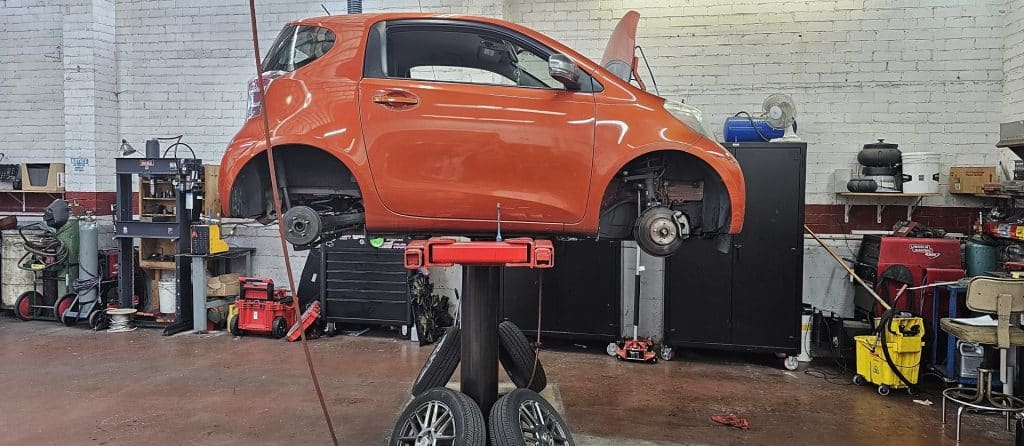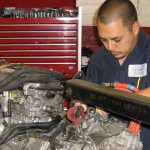During our 40+ years in Berkeley, we’ve learned a lot about what car service & maintenance is critical, and what service items can be postponed relatively safely if money is tight. This page provides an overview of common maintenance items and service schedules, along with explanations of why each task is important.
We also have service web pages for each of the brands we repair: Toyota, Honda, Subaru, and Mazda. If you’d like more specific information about the services we offer for each brand, check these pages out.

Table of contents
Why should you listen to us?
We’ve been providing car repairs and service in Berkeley since 1980 — over 40 years. Through our years of experience we’ve developed opinions about what service items are important for longevity and what’s not. In this article we hope to give you the information you need to make up your own mind and make decisions that are in line with your goals.
What service do cars need?
Whether you like the term “tune-up”, car service, or factory recommended maintenance, it all amounts to the same thing: keeping your car running well and preventing avoidable expense and inconvenience.
The items in the following list will be found in virtually every vehicle’s owner’s manual in the maintenance section. These are the service items that make up a tune-up, car service, or whatever you like to call preventative maintenance.
- Replacing oils and fluids before they degrade and cause your car to start wearing very quickly.
- Replacing coolant before its boiling and freezing points change and before its anti-corrosive additives fade away
- Adjusting valves before a tight valve causes engine damage
- Replacing filters before they start to clog
- Rotating the tires so they will last longer
- Replacing spark plugs before they wear and cause a misfire and catalyst damage
- And perhaps most importantly, inspecting the car so we can find small problems before they develop into big problems.
Who can you trust?
Most mechanics agree on what should be done to maintain a car, but frequently we disagree on when it should be done. Auto shop “A” might accuse auto shop “B” of “wallet flushing” if they recommend fluids earlier than Shop A thinks appropriate.
So what is the gold standard? Who should decide? Should it be the engineers that designed the car? Should it be the individual dealerships? Should it be independent mechanics? Should it be the owner of the car? Who knows what’s best for the car in the long run?
Engineers?
The engineers who designed the car take a guess at what maintenance it will need, but it’s backed up with all the simulations and calculations that engineers are so good at. However, sometimes the real world doesn’t run like the simulation, and their recommendations turn out to be insufficient for long life.
Also, there is pressure to reduce the amount of required maintenance because it drives up the total cost of ownership. Total cost of ownership is a number that fleet buyers and rental car companies look at when choosing vehicles, and a low total cost of ownership makes a car more desirable. This pressure sometimes results in minimal service requirements.
Sometimes we’ve found that a Toyota and Lexus that share the same drivetrain will have different service requirements, even though they are the same car mechanically. A luxury car is more likely to have a realistic service schedule since it’s not destined for fleets and the intended customer is better able to afford higher maintenance costs. Basically, the factory recommended service schedule can be influenced by factors not related to what would be best for the car, and there also may be some miscalculation in the car service recommendations.
Dealerships?
So how about the dealerships? Here’s the thing, dealerships are individual shops, and they all have different cultures and policies. Some dealerships have a good culture, good techs, and good car service recommendations. Others, not so much.
Many dealers are of the corporate variety, and tend not to have the same moral character as privately owned dealerships. The corporation incentivizes profit over everything else; the management hires green techs straight out of school and offers low base pay with lots of incentives to sell work and perform it quickly.
This variety of dealership often sells a lot of maintenance items that are not on the list in the owner’s manual, are very profitable, and don’t add to the reliability of the car. So, in short, a dealer may be offering sage advice when recommending early maintenance or maintenance that’s not on the owner’s manual list, or they may be trying to line their pockets.
Independent repair shops?
Independent shops (like Art’s Automotive), must be the well from which all good maintenance advice springs, right? Nah. Independent shops are like dealerships. Some are filled with talented and wonderful human beings, some are literally criminals, committing fraud on a daily basis. There are fewer corporate owned independent shops, and I suspect there are fewer bad apples among the non-chain independents, but I have no data to back this up.
The car’s owner?
So, how about the vehicle’s owner? Is he or she the one who can determine what’s best for the car? Well, ultimately the owner IS the one who decides what should be included in a tune-up since he has the car and wallet. However, most owners haven’t had a chance see years of failure patterns on specific models and cars in general.
So, deciding what car service work should be performed really needs to be a team effort. The owner needs to work with a competent and honest shop to determine what maintenance should be done and when it should be done. The owner needs to impart their philosophy and long term plans for the vehicle and the mechanic needs to develop a game plan to achieve the owner’s goals. In other words, you’ll need a mechanic you can trust. If you can’t find one, just stick with the scheduled maintenance as outlined in the owner’s manual. However, you may end up under-maintaining the car a bit.
Maintenance Minder?
Many vehicles have a maintenance reminder system to alert the driver when car service is due. Some systems are nothing more than a mileage counter that alerts “x” number of miles since the last reset. This type of system will usually have a Maint Req light that will show up on the dash.
Some systems like Honda’s Maintenance Minder systems are more advanced. The Maintenance Minder system actually monitors driving habits and alerts the driver when a service should be performed based on mileage AND driving conditions. It also tracks most of the service items, not just the oil and filter. Pretty cool, in theory at least.
Honda’s maintenance minder system isn’t perfect. Its biggest problems are caused by mechanics:
- Failing to reset the appropriate service item minder when when the service is done
- Resetting a service item when it hasn’t been done
It’s a lot easier for this to happen than you might imagine. Let’s say a mechanic checks the transmission fluid and it’s bad. He replaces the fluid. The maintenance minder “3” (replace transmission fluid) wasn’t on at the time the fluid was replaced, and there isn’t a way to reset the maintenance minder 3 without the factory scan tool. We have one, but most shops don’t, and even a shop has the means to reset the minder, they may forget.
The other scenario occurs when a shop changes the motor oil with a maintenance minder A or B service. There may be other services due at the same time, but if they’re not done for any reason, they’ll often be cleared anyway, because unless a factory scan tool is used, all maintenance minder items that are displayed are cleared during the reset procedure.
Newer Honda’s now have a menu-driven dashboard interface where a mechanic or vehicle owner can selectively reset all of the maintenance items individually, which is a very nice upgrade.
Should maintenance be performed on a schedule?
Some maintenance items can be tested or inspected to determine whether they need car service. This brings up the question of whether a maintenance item should be replaced before it goes bad, or after it goes bad. This is a personal choice for the vehicle’s owner and there are valid arguments for each side of the decision. Below are some of the routine maintenance items and how they can be inspected.
Car service items
Engine air filter
If the air filter is held up to the light, you should be able to see light through the pleats. How much blocked light is “bad” is somewhat subjective, but most folks can agree on what’s “good” and what’s “bad”.
Cabin air filter
Depending on the car, the cabin filter may be easy to remove and check or very difficult. Once out, the cabin filter is checked in the same way as the engine air filter. If the cabin filter is difficult to remove, it may make more sense to just replace it on a mileage interval.
Engine oil and filter
Oil changes color and becomes thicker as it wears out (yes, motor oil does wear out). However, there are really only two observable states of motor oil, very bad and very good. Motor oil can be sent out for lab testing, but simply replacing it costs less.
Automatic transmission fluid
ATF may start life as red, blue, green, or clear. As it degrades, its smell and color change. Its color will darken, turn brown, and if left unaddressed for long enough it may even turn black. ATF’s smell goes from waxy to sharp to a burnt electrical smell. You may also notice debris floating in the fluid if you look closely. If gray, it’s likely metal. If brown, it’s likely clutch material. We recommend replacing ATF as soon as it starts to turn color.
Manual transmission oil
Gear oil does not tend change color. Also, it starts out anywhere from clear to brown, so it’s hard to tell anything by its color. When you check gear oil, you only see the oil at the top of the sump, so if there is any metal debris, it has likely floated to the bottom of the sump. Because it is difficult to gage the condition of gear oil, it’s best to replace it on a schedule. If the last service mileage is unknown, it’s best to replace it and then start on a schedule.
Gear oil
Transfer case oil, front differential oil, and rear differential oil is the same as manual transmission oil as far as checking condition.
Brake fluid: Brake fluid is hygroscopic, meaning it adsorbs moisture from the air. Water is bad for the brake hydraulic system for a couple of reasons. First, the water can lead to oxidation of the metal in the system. Rust on the steel and aluminum oxide for the aluminum parts. Both forms of oxidation lead to pitting and leaking. The second reason water is bad for the brake system is that the boiling point of water saturated brake fluid is lower than when it’s fresh. This can lead to a low, spongy, ineffective brake pedal.
The other reason to change brake fluid debris build-up. There are moving parts made of steel, aluminum, plastic, and rubber. As these parts wear material sloughs off and is suspended in the fluid. This grit can abrade other components and increase the rate of wear. There are 4 methods of gaging brake fluid condition: measuring its electrical conductivity, measuring its copper content, measuring its boiling point, and checking for “mud” in the reservoir. Typically the OEs that recommend brake fluid flushing recommend an interval of 3 years or 30K miles. At this interval, the fluid will usually still test good.
Coolant
Coolant can be tested in a couple of ways. The ratio of ethylene glycol to water can be checked with a hydrometer or a refractometer. We can also check the PH of the coolant. For Japanese cars and Kia/Hyundai the PH should be 8. If the PH is higher, it means the incorrect coolant has been installed. If the PH is lower, the coolants anti-corrosive properties have degraded.
Spark plugs
Spark plugs can be visually inspected. The center electrode should be a cylinder with a sharp edge. As the plugs wear the edges of the center electrode and ground electrode become rounded and the gap increases.
It’s a lot easier to tell that conventional plugs are worn because the center electrodes are much larger and are easier to see. It’s best to replace plugs at the recommended interval rather than trying to gage the condition.
If you’re going the DIY route, watch out for fake spark plugs from EBay, Amazon, Ali Express, and even a dealership in one case.

Valve adjustment
When valve clearance is excessive, or “loose” a camshaft speed ticking noise can be heard. When valve clearance is insufficient, or “tight”, there will be no noise at all. Unfortunately when a valve is tight it causes excessive engine wear, so the most dangerous valve clearance condition is undetectable. Once the valve clearance is tight enough, the engine may start to misfire in the morning when the engine is cold. This will be most noticeable at idle. If left to progress, the engine will be damaged and will need major repairs. This is an area where experience pays off. Some cars, like the 1997 – 2001 Honda CRV and 1995 -2004 Toyota Tacoma 2.4 and 2.7 liter engine need valve adjustments MUCH more frequently than the factory recommends. Many of these vehicles had engine damage before the first valve adjustment was due.
Throttle Body Cleaning
Throttle body service is a wobbler. Should it be regular maintenance, or should it be performed only as needed to address a symptom? None of the manufacturers that we repair recommend throttle body service based on mileage or age. However, if left unaddressed the throttle body will eventually cause problems when it gets dirty. Isn’t that what preventative maintenance is for? Addressing issues that will cause problems later?
If you’re interested in learning more about throttle body service here’s an article covering the subject of throttle body cleaning.
If you’re not sure about what service your car needs, ask
Keeping a car running well for a long time requires diligence. It’s a lot cheaper to maintain a car than it is to neglect it and repair it when it breaks. Many folks end up under-maintain their cars not because they don’t want to perform the maintenance, but because they just didn’t know that there was something they needed to do.
This is where communication with your mechanic comes in. If you come in and say, “I want an oil change”, we’ll do an oil change. We’ll mention anything we notice, but we won’t go digging through the file to check what’s been done and what needs doing and the car may need service that’s not getting done.
However, if you ask us, we’ll happily check our service records to see what’s needed. Even if the car has never been here we can dig through your old receipts and piece together a service history and make recommendations based on what we find.
If You’re In Berkeley And Your Car Needs Service, Call Us!
If you’re searching for a trustworthy shop to service your car in Berkeley or nearby cities like Emeryville, Oakland, Albany, El Cerrito, Richmond, and Orinda, and we seem like we might be a good fit for you, please give us a call. Thanks for reading!
Our Primary Auto Repair Services & Other Collections
Below are links to some of the other automotive maintenance, repair, and diagnostic services we offer at Art’s Automotive, including a link to our services page, which is a collection of articles explaining all of the services we provide. We also have a collection of articles about our shop and how we do business and a collection of informative blog type articles we’ve written over the years.
Car Electrical Repair in Berkeley – Art’s Automotive
Art's Automotive provides fast, accurate diagnosis and repair of all types of car electrical problems. We serve Berkeley and the nearby cities Oakland, Emeryville, El Cerrito, and Richmond. Not only...
Mazda Service & Repair In Berkeley – Art’s Automotive
Art's Automotive has been servicing Mazda vehicles in Berkeley for over 40 years now. Mazda isn't our biggest brand, but they're popular in the Bay Area and they make some...
Honda service & Repair in Berkeley – Art’s Automotive
At Art’s Automotive, our goal is to keep your Honda running reliably and your costs low by providing an intelligent service plan and fairly priced repair. On this page, you’ll...
Toyota Service & Repair in Berkeley – Art’s Automotive
If you're looking for a shop in Berkeley to service your Toyota, this page will give you an idea of what to expect at our shop, and explain what we've...
Subaru Service & Repair In Berkeley – Art’s Automotive
Whether you're one of our customers in Berkeley or just someone researching the service and maintenance needs of your Subaru, we hope you'll find this article useful. It's our honest...
Hybrid Service in Berkeley, East Bay | Art’s Automotive
Are you looking for hybrid or EV service, diagnosis, or repair in Berkeley? Art's Automotive is the East Bay's leading hybrid & EV specialist. On this page we'll try to...








